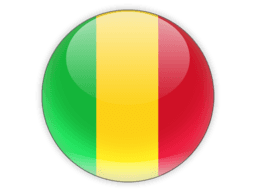
Cities of Mali
Discover 64 cities across 11 regions
Kayes(7)
Kidal(1)
Koulikoro(15)
Mopti(7)
Ségou(12)
Sikasso(11)
Taoudénit(1)
Mali is a landlocked country in West Africa with an estimated population of over 20 million people. It is the eighth largest country in Africa and is bordered by Niger, Algeria, Mauritania, Senegal, Guinea, Ivory Coast, Burkina Faso, and Ghana.
Mali has a rich cultural heritage and is known for its vibrant music scene. The country has a diverse population with over 40 ethnic groups, each with their own unique languages and customs.
The majority of Mali's population is Muslim, with a small Christian and Animist minority. The official language is French, although many people also speak Bambara, which is the most widely spoken language in the country.
Mali has a hot, dry climate with most of the country covered by desert or semi-desert. The Niger River is the lifeblood of the country and provides water for irrigation and transportation.
Mali's economy is largely based on agriculture, with cotton being the country's largest export. Mining, especially of gold and salt, is also an important industry in Mali. However, the country faces numerous challenges, including poverty, political instability, and conflict.
Tourism is a growing industry in Mali, with visitors attracted to the country's rich history and cultural heritage. Popular tourist destinations include the city of Timbuktu, known for its Islamic architecture and ancient manuscripts, and the Dogon Country, a UNESCO World Heritage site known for its unique cliff-dwelling villages and rock paintings.
Telephone Code
223
Local Emergency Phone
Ambulance: 15; Fire: 17; Police: 18
Vaccinations
An International Certificate of Vaccination for yellow fever is required for all travelers. See WHO recommendations.
Climate
Subtropical to arid; hot and dry (February to June); rainy, humid, and mild (June to November); cool and dry (November to February)
Currency (Code)
Communaute Financiere Africaine francs (Western African CFA francs, XOF)
Electricity/Voltage/Plug Type(s)
220 V / 50 Hz / plug types(s): C, E
Major Languages
French, Bambara, Peul, Dogon, Maraka, Malinke, Sonrhai/Djerma, Minianka, Tamacheq, Senoufo, Bobo note: Mali has 13 national languages in addition to French
Major Religions
Muslim 93.9%, Christian 2.8%, animist .7%, none 2.5%
Potable Water
Opt for bottled water
International Driving Permit
Suggested
Road Driving Side
Right
Tourist Destinations
Timbuktu; Bamako; Grand Mosque of Djenne; Mopti; Mount Hombori; Tomb of Askia in Gao
Major Sports
Soccer, basketball
Cultural Practices
Pointing at people with the index finger is considered rude. Use the whole hand to gesture instead.
Tipping Guidelines
Tipping porters $1 (USD) per bag and hotel staff $1-2 (USD) per day is appropriate. Professional guides and/or drivers who accompany you throughout a visit should be tipped $10 (USD) per day.
Souvenirs
Carved-wood native items, including masks and musical instruments; iron and copper swords and knives; pottery; woven cloth; gold, silver, and wood jewelry
Traditional Cuisine
Tiguadege Na — a peanut butter stew prepared with lamb or chicken and large chunks of potatoes and carrots
Geography
Area
total: 1,240,192 sq km
land: 1,220,190 sq km
water: 20,002 sq km
Climate
subtropical to arid; hot and dry (February to June); rainy, humid, and mild (June to November); cool and dry (November to February)
Natural resources
gold, phosphates, kaolin, salt, limestone, uranium, gypsum, granite, hydropower, note, bauxite, iron ore, manganese, tin, and copper deposits are known but not exploited
People and Society
Population
21,359,722 (2023 est.)
Ethnic groups
Bambara 33.3%, Fulani (Peuhl) 13.3%, Sarakole/Soninke/Marka 9.8%, Senufo/Manianka 9.6%, Malinke 8.8%, Dogon 8.7%, Sonrai 5.9%, Bobo 2.1%, Tuareg/Bella 1.7%, other Malian 6%, from members of Economic Community of West Africa 0.4%, other 0.3% (2018 est.)
Languages
French (official), Bambara 46.3%, Peuhl/Foulfoulbe 9.4%, Dogon 7.2%, Maraka/Soninke 6.4%, Malinke 5.6%, Sonrhai/Djerma 5.6%, Minianka 4.3%, Tamacheq 3.5%, Senoufo 2.6%, Bobo 2.1%, other 6.3%, unspecified 0.7% (2009 est.)
Religions
Muslim 93.9%, Christian 2.8%, animist 0.7%, none 2.5% (2018 est.)
Population growth rate
2.93% (2023 est.)
Government
Government type
semi-presidential republic
Capital
name: Bamako
Economy
Economic overview
low-income Saharan economy; recession due to COVID-19 and political instability; extreme poverty; environmentally fragile; high public debt; agricultural and gold exporter; terrorism and warfare are common
Real GDP (purchasing power parity)
$46.452 billion (2021 est.)
Real GDP per capita
$2,100 (2021 est.)
Agricultural products
maize, rice, millet, sorghum, mangoes/guavas, cotton, watermelons, green onions/shallots, okra, sugar cane
Industries
food processing; construction; phosphate and gold mining
Exports
$5.196 billion (2020 est.)
Exports - partners
United Arab Emirates 66%, Switzerland 26% (2019)
Exports - commodities
gold, cotton, sesame seeds, lumber, vegetable oils/residues (2019)
Imports
$6.339 billion (2020 est.)
Imports - partners
Senegal 23%, Cote d'Ivoire 15%, China 11%, France 9% (2019)
Imports - commodities
refined petroleum, clothing and apparel, packaged medicines, cement, broadcasting equipment (2019)
International Airports in Mali
Discover 4 major airports serving Mali
Mark Mali as Visited
Add Mali to your personal travel map and track your journey around the world. Share your adventures and see your progress grow!